Abstract
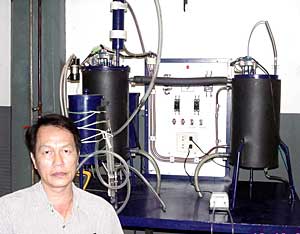
Gumpon Prateepchaikul with Prince of Songkla University's Faculty of Engineering 5-litre laboratory-scale biodiesel reactor (designed by Prof. Michael Allen).
|
Due to unstable oil price situation in the world market, many countries have been looking for alternative energy to substitute petroleum. Vegetable oil is one of the alternatives which can be used as fuel in automotive engines either in the form of straight vegetable oil, or in the form of ethyl or methyl ester. This paper presents a comparative performance testing of diesel engine using diesel oil and refined palm oil over 2,000 hours of continuous running time. Short-term performance testing was conducted for each fuel on the dynamometer engine test bed. Specific fuel consumption, exhaust temperature and black smoke density were determined and measured. Long-term performance testing (or endurance test) was also done by running the engines coupled with a generator in order to supply load (electricity) to a lightbulb board. For each 500 hours of engine run time, the engines were dissembled for engine wear inspection. It was found that the fuel pump and fuel valve weight losses from both engines showed insignificant differences either at the first 500 hours of running time or at the second 500 hours of running time but the inlet valve from the engine fueled by diesel oil had higher weight loss than the engine fueled by refined palm oil at the first 500 hours and at the second 500 hours of running time. The compression rings from the engine fueled by refined palm oil showed a significant weight loss compared to the engine fueled by diesel oil both at the first 500 hours and at the second 500 hours of running time.
Key words : refined palm oil, diesel engine test, palm oil fuel substitute
Palm Oil as a Fuel for Agricultural Diesel Engines: Comparative Testing against Diesel Oil
In 1999 energy consumption in Thailand was 47,699 ktoe (kilo ton of oil equivalent) which increased by 4.4% over the previous year. Petroleum products and other modern energies such as natural gas, condensate, coal and lignite increased by 4.3% [Department of Energy Development and Promotion, 1999]. The total crude oil production was 1,694 ktoe and the total crude oil imported was 34,860 ktoe. Transportation sector consumed 18,991 ktoe. Diesel shared 54.1% while gasoline shared 27.1%. Due to the increasing oil price in the world market and in the country, the agricultural sector, which consumed 4.5% of the total energy consumption, has suffered greatly because of the declined crop price and high fuel price. The thought of using vegetable oil as fuel substitute was spread throughout the country. Several formulae of blending vegetable oils by groups of farmers were used in diesel engines without any technical support so after some period of time all formulae of blending vegetable oils were terminated because of engine failures. Providing the technical information to farmers or users is thus most important. Study of using refined palm oil as fuel substitute in agricultural engines has been conducted at the Department of Mechanical Engineering, Prince of Songkla University, Thailand.

This Thai train runs daily from Hatyai District (South Thailand) to Sugaikolok district (Thailand-Malaysia border), a distance of 214 km, using 50% biodiesel from stearin palm oil.
|
Researches on the use of vegetable oils as fuel substitutes in diesel engines have been done in many countries. Peter et al. (1982) used degummed soybean mixed with diesel oil at the ratio of 2:1 as fuel in a diesel engine. After 600 hours of running it was found that the engine performance did not alter. Certain researchers found that 95% vegetable oil blending with 5% diesel oil in a diesel engine gave no problem of carbon deposit on the engine parts or in the fuel injector. Adam et al. (1983) tested an agricultural machine with blend oil (soybean oil and diesel oil) and found that by using soybean blended with diesel oil in the ratio of 2:1, the engine worked well. Kevin et al. (1999) concluded that by using semi-refined rapeseed oil (SRO) in the direct injection diesel engine, the power output reduced by 0.06% for every 1% increase in SRO inclusion rate and the brake specific fuel consumption increased by 0.14% per 1% increase in SRO inclusion rate. Chiyuki and Jun-ichi (1998) concluded that deacidified rapeseed oil could be used in a single cylinder YANMAR IDI diesel engine but degummed and crude rapeseed oil were unsuitable for use as fuel due to the high level of incombustible materials in the oil. Suporn (1987) found that using 100% refined palm oil in a KUBOTA diesel engine model KND 5B resulted in the best power output and best emission while using 70% refined palm oil blended with 25% diesel resulted in the best specific fuel consumption.
Materials and Methods
Fuel Preparation
Refined palm oil was used in the test. Characteristics of refined palm oil such as Cetane number, specific gravity, viscosity, gross heat of combustion, flash point, carbon residue were tested according to ASTM Standard by PTT Research and Technology Institute, PTT Public Company Limited. The characteristics of refined palm oil and diesel oil are shown in Table 1.
Short-Term Engine Testing Equipment
Short-term engine performance tests were done according to JIS B8018 (1989): Small- size water-cooled diesel engines in land use, with both 100% diesel oil and 100% refined palm oil in comparison. Figure 1 is the JIS B8018 (1989) profile test.
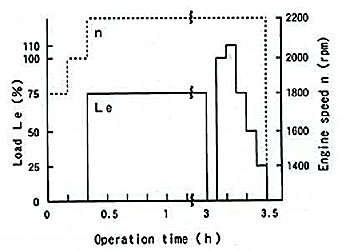
Figure 1 JIS B8018 (1989) Standard profile test
|
Engine and Dynamometer
Two KUBOTA Model ET80 single cylinder indirect injection diesel engines were used. The bore to stroke ratio is 84:84 mm. x mm. The maximum power is 5.88 kW at 2200 rpm. The compression ratio is 23:1. The engines were run with either diesel oil or refined palm oil for comparison. A PLINT & PARTNERS 12 horsepower dynamometer coupled to the engine was used for determining the engine performance.
|
Table 1 Properties of diesel and refined palm oil
|
| Fuel property |
Specification
|
Diesel
|
Refined palm oil
|
Standard
|
|
Cetane Number
|
>47
|
NA
|
50
|
ASTM D-613
|
| Specific gravity at 15.6oC |
>0.81, <0.87
|
0.84
|
0.92
|
ASTM D-1298
|
| Viscosity at 40oC (cSt) |
>1.8, <4.1
|
3.1
|
40.9
|
ASTM D-445
|
| Flash point (oC) |
>52
|
69
|
>300
|
ASTM D-93
|
| Water and sediment (%) |
<0.05
|
NA
|
Traces
|
ASTM D-2709
|
| Carbon residue (%) |
<0.05
|
<0.001
|
0.217
|
ASTM D-4530
|
| Ash (%) |
<0.01
|
NA
|
0.001
|
ASTM D-482
|
| Distillation temp (oC) |
<357
|
NA
|
319
|
ASTM D-86
|
| High heating value (MJ/kg) |
-
|
44.3
|
39.3
|
ASTM D-240
|
| NA: Not Available |
Opacity Meter
A portable HESHBON Opacity meter model HBN-1500 was connected to the exhaust pipe of the engine to measure the smoke density of the exhaust gas. The exhaust gas was pumped into the meter in which a filter paper was inserted. Black particulates from the exhaust gas were trapped on the filter paper and then it was tested for the opacity compared with a standard filter paper. The meter provides an output reading between 0.00-100.00% with the resolution of 0.1%.
Tachometer
A DIGICON model DT-240P non-contact tachometer with the range from 5-100,000 rpm and the resolution of 1 rpm was used to measure the engine speed.
Long -Term Engine Testing Equipment

The two Kubota agricultural diesels under test. A small supplementary petro-diesel tank was used to start the motors although the Kubotas would start from cold on high olein palm oil. The exhaust pipe was routed through the palm-oil tank to heat the fuel. Because the motors ran unattended for most of the time, 200-litre drums were used as fuel tanks. The photograph shows the exhaust pipe of the nearer motor entering the bottom of the tank.
|
The long-term performance test was done to examine the effect of refined palm oil on engine durability comparing to diesel oil. One of the engines was run on diesel oil and the other was run on 100% refined palm oil. After every 500 hours of running, the engine was put back to the dynamometer for the short-term performance test to investigate the variations in its performance. Then the engine was dissembled to be visually checked for wear and weight loss of some parts of the engine such as piston rings, cylinder head, piston pump and inlet and exhaust valves. Samples of used lubricating oil were taken every 100 hours of 1000 hours for both engines and were sent to PTT Research and Technology Institute for wear test. Because of high expense in oil sample analysis, the samples were limited to 10 samples of each fuel.
Engine and Generator
For long term test, each engine was mounted on a stand and was coupled with a 7.5 kW, 230 Volts, 32.6 Amps, 50 Hertz, 80% efficiency electric generator. The electricity generated was supplied to series of light bulbs for varying engine loads.
Procedures
The purpose of short-term test was to determine the engine performances. Several load conditions were tested on each engine. Parameters of interest such as fuel consumption, torque, exhaust temperature were recorded, then the engine performances (specific fuel consumption, thermal efficiency) were determined. The engine components were then disassembled. The components such as piston rings, inlet and exhaust valves, fuel pump, fuel valve and bearing were weighed after the first 50 hours of running (run-in time) and after every 500 hours of run time.
The purpose of the endurance test was to determine how long the engine fueled with 100% refined palm oil could be run.
Start up procedures
Two brand-new KUBOTA Model ET80 engines were used in the test. It is assumed that both engines have the same characteristics. Both engines were run in for 50 hours according to the manufacturer's specification, then the engines were disassembled. Fuel pumps, fuel valves, inlet valves, exhaust valves, piston rings and bearings were weighed against initial conditions of the engine components. After reassembling the engine, it was coupled with the dynamometer for performance test according to JIS standard B 8018 (1989): Small-size water-cooled diesel engines in land use. One engine was run on diesel oil while the other was run on refined palm oil.
After the short-term test, the engines were coupled with generators for endurance test. For the endurance test, the engine operated at 2,200 rpm, 75% of maximum load. A lightbulb board was connected to the generator. The electricity generated was supplied to the light bulbs. Lubricating oil was changed for every 100 hours and sample of used lubricating oil was collected. After 500 hours of running, the engines were moved to test with the dynamometer and engine components were disassembled for inspection with the same procedures as mentioned above. Then the engines were tested for endurance test for the next 500 hours.
Results
The results are is divided into two parts. The first part is the result of the short-term performance tests especially specific fuel consumption, thermal efficiency, exhaust temperature and smoke density of the engines fueled with diesel oil and refined palm oil. The second part deals with the result of the used lubricating oil analysis.
Results of the first part
Specific fuel consumption
Results from the test of the engines fueled by diesel oil and refined palm oil indicate that the specific fuel consumption of the engine fueled by diesel oil is 14.2-19.0% less than that fueled by refined palm oil at the first hour of running. The specific fuel consumption of the engine fueled by diesel oil is 19.3-25.8% less than the engine fueled by refined palm oil at 500 hours of running and 15.1-20.3% less at 1000 hours of running as shown in Figure 2. This is because the heating value of the refined palm oil is about 10% less than that of diesel oil causing a higher specific fuel consumption of the engine fueled by refined palm oil than the engine fueled by diesel oil.
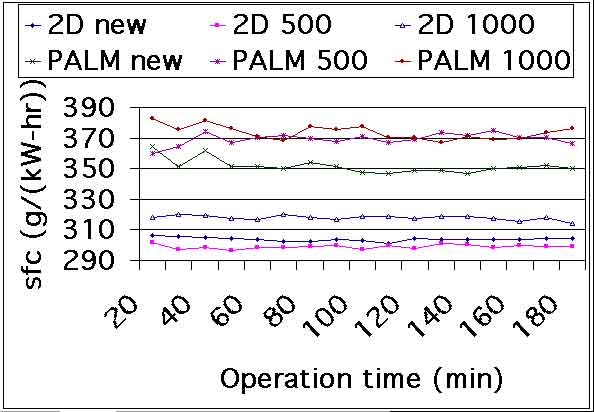
Figure 2 The specific fuel consumption of the engines fueled by diesel and refined palm oil at the first hour (new), 500 hours and 1,000 hours of running time
|
Thermal efficiency
The thermal efficiency of the engine fueled by diesel oil is 0.5-1.4% higher than the engine fueled by refined palm oil at the first hour of running, then becomes 1.5-2.8% higher at 500 hours of running and finally becomes 0.5-1.6% higher at 1,000 hours of running as shown in Figure 3. This is because of the incomplete combustion of refined palm oil in the combustion chamber of the engine.
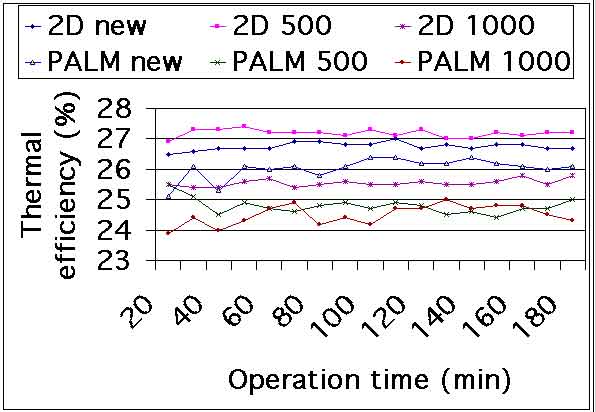
Figure 3 Thermal efficiency of the engines fueled by diesel and refined palm oil at the first hour (new), 500 hours and 1,000 hours of running time
|
Exhaust gas temperature
The exhaust gas temperature of the engine fueled by refined palm oil is higher than the engine fueled by diesel oil throughout the test. This is because of the incomplete combustion of refined palm oil in the combustion chamber of the engine, some of the unburned fuel escapes into the exhaust manifold and combustion takes place in the exhaust manifold causing the high exhaust temperature.
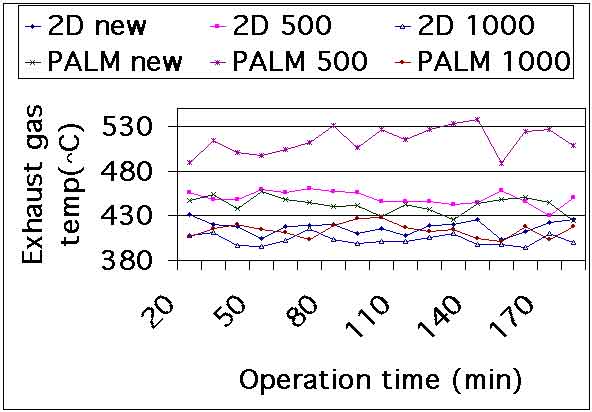
Figure 4 The exhaust gas temperature of the engines fueled by diesel and refined palm oil at the first hour (new), 500 hours and 1,000 hours of running time
|
Black smoke density
The black smoke density from both engines was almost the same at the first hour and 1000 hours of running but the black smoke density from the engine fueled by refined palm oil is about 5% higher at 500 hours of running as shown in Figure 5. This is because of the incomplete combustion of the refined palm oil in the combustion chamber causing higher black smoke than the engine fueled by diesel oil.

Figure 5 The black smoke density of the engines fueled by diesel and refined palm oil at the first hour (new), 500 hours and 1,000 hours of running time
|
Results of the second part
Engine wear analyses
Analyses of used lubricating oil from samples taken at every 100 hours of engine run time indicate that metal contents such as Lead, Chromium, Aluminum, Copper and Silicon in the oil from the engine fueled by refined palm oil are higher than those from the engine fueled by diesel oil, but ferrous content is almost the same, as shown in Figure 6 and Figure 7.
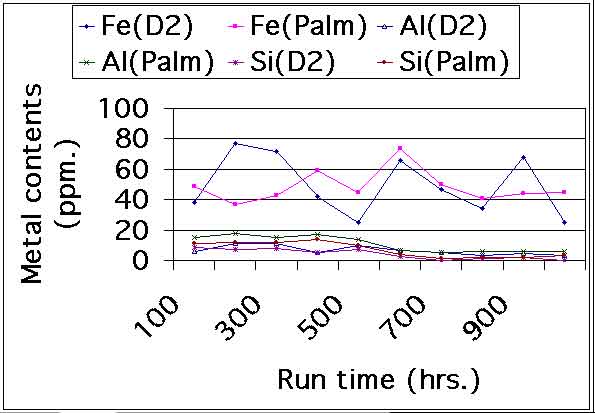
Figure 6 Ferrous, Aluminum and Silicon content in used lubricating oil from the engines fueled by diesel and refined palm oil for every 100 hours of running time
|
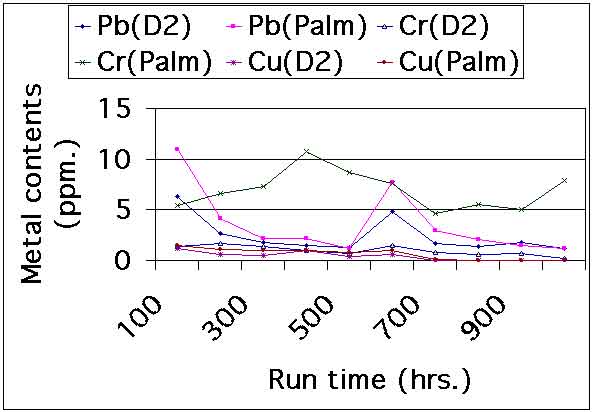
Figure 7 Lead, Chromium and Copper content in used lubricating oil from the engines fueled by diesel and refined palm oil for every 100 hours of running time
|
Weighing the components of the engine at the beginning of the test and after each 500 hours of running is a way to evaluate engine wear. It is found that the weight losses from fuel pump, fuel valve, inlet valve, exhaust valve and piston rod bearing are almost the same for both engines fueled with diesel and refined palm oil, as shown in Figure 8.
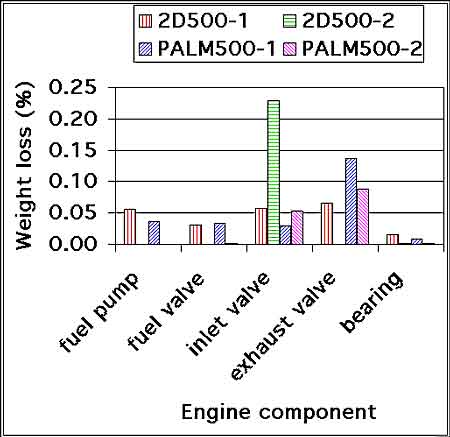
Figure 8 Engine component wear from the engines fueled by diesel and refined palm oil at the first 500 and the second 500 hours of running time
|
Compression ring from the engine fueled by refined palm oil has the most significant weight loss. At the first 500 hours of running, the compression ring from the engine fueled by refined palm oil has 6.1 times weight loss higher than the engine fueled by diesel oil and 4.4 times at the second 500 hours as shown in Figure 9. Figures 10 and 11 show the cumulative component wears at the first 1,000 hours of running time for both engines and the component wear at the second 1,000 hours of running time for the engine fueled by refined palm oil. The cumulative wear is 5.2 times higher for the engine fueled by refined palm oil which is in agreement with the increase in piston ring gap as shown in Table 2.
|
Table 2 Comparison of piston ring gap of the engine fueled by diesel and refined palm oil after the first 1,000 hours of run time and the second 1,000 hours of run time from the engine fueled by refined palm oil
|
| Piston ring |
Standard new ring (mm)
|
Maximum allowable value (mm)
|
Diesel oil at 1000 hours (mm)
|
Refined palm oil at 1000 hours (mm)
|
Refined palm oil at 2000 hours (mm)
|
| Compression ring #1 |
0.2-0.4
|
1.2
|
0.4
|
0.7
|
1.0
|
| Compression ring #2 |
0.2-0.4
|
1.2
|
0.5
|
0.7
|
1.2
|
| Compression ring #3 |
0.2-0.4
|
1.2
|
0.5
|
0.8
|
1.2
|
| Oil ring |
0.2-0.4
|
1.2
|
0.3
|
0.4
|
0.6
|
After 2,000 hours of running time, the piston rings wear was still high and caused an increase in ring gap. The exhaust valve stem clearance was increased, causing carbon and gum deposits on the valve covers.

Figure 9 Piston rings wear from the engine fueled by diesel and refined palm oil at the first 500 and the second 500 hours of running
|
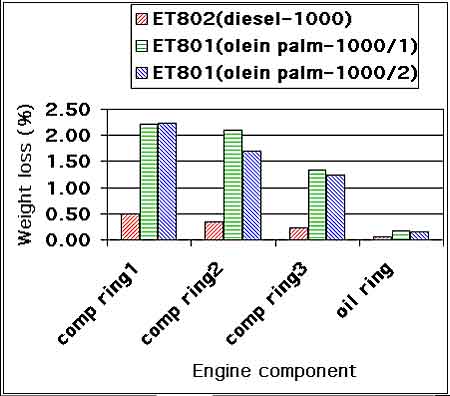
Figure 10 Component wear from the engine fueled by diesel and refined palm oil at the first 1,000 hours and the second 1,000 hours of running from the engine fueled by refined palm oil
|
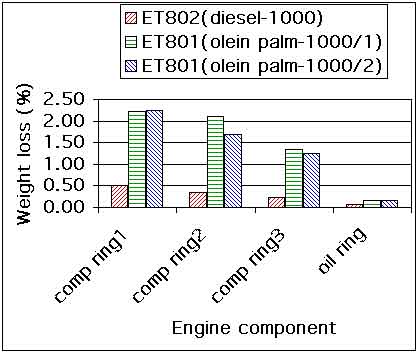
Figure 11 Piston rings wear from the engine fueled by diesel and refined palm oil after the first 1,000 hours and the second 1,000 hours of running from the engine fueled by refined palm oil
|
Discussion
Results show that using 100% refined palm oil in a KUBOTA diesel engine and operating continuously at constant 75% maximum load and 2,200 rpm for 2,000 hours produce no serious problems. Starting the engine with refined palm oil is quite difficult because of its high viscosity and high flash point.
Specific fuel consumption and thermal efficiency of the engine fueled with refined palm oil are lower because of its low heating value.
Results of used lubricating oil analyses and components weighing indicate the similar trend, i.e. engine fueled by refined palm oil gives higher wear than that fueled by diesel oil. Because of incomplete combustion of refined palm oil, some of the unburned fuel adheres to the clearance between the cylinder liner and piston rings.
Conclusion
Comparative tests of indirect injection agricultural engines fueled by diesel and refined palm oil and operating continuously at constant 75% maximum load and speed of 2,200 rpm indicate that for the first 1,000 hours of operation the specific fuel consumption of the engine fueled by refined palm oil is 15-20% higher. The black smoke density is not significantly different in the two cases. Wear in the engines fueled by refined palm oil and diesel oil is not significantly different but wear in the compression rings of the engine fueled by refined palm oil is significantly higher.
Acknowledgements
The author would like to thank the Chaipattana Foundation for the support of the project and Department of Customs (Sadao section) for supplying the palm oil in the project .
References
Department of Energy Development and Promotion, Ministry of Seience, Technology and Environment, Thailand Energy Situation 1999: Annual Report.
Adams, C., Peter, J.F., Rand, M.C., Schroer, B.J. and Ziemke, K.C. 1983. Investigation of Soybean Oil as a Diesel Fuel Extender: Endurance Tests, JAOCS. 60(1983), 1574-1579.
Chiyuki, T. and Jun-ichi, K. 1998. Operation of a Diesel Engine using Unrefined Rapeseed Oil as Fuel, http://www.ss.jircas.affrc.go.jp/jarq/32-2/Togashi/togashi.html. (Feb, 3, 1999)
Kevin, P.M., Shane, S.W. and Paul, B.M. 1999. Results of Engine and Vehicle Testing of Semi-Refined Rapeseed Oil, Proceedings of the 10th International Rapeseed Congress. Canberra, Australia. 1999. http://www.regional.org.au/au/gcirc/6/214.htm.
Peter, J.F., Rand, M.C. and Ziemke, M.C. 1982. Investigation of a Soybean Oil as Diesel Fuel extender, SAE Paper No.823615.
Suporn, K. 1987. Using of Palm Oil in Diesel Engine, Senior Project ME17/1987, Department of Mechanical Engineering, Faculty of Engineering, Prince of Songkla University, Hat Yai.
Biofuels at Journey to Forever
Biofuels
En español -- Biocombustibles, biodiesel
Biofuels Library
Biofuels supplies and suppliers
Biodiesel
Make your own biodiesel
Mike Pelly's recipe
Two-stage biodiesel process
FOOLPROOF biodiesel process
Biodiesel processors
Biodiesel in Hong Kong
Nitrogen Oxide emissions
Glycerine
Biodiesel resources on the Web
Do diesels have a future?
Vegetable oil yields and characteristics
Washing
Biodiesel and your vehicle
Food or fuel?
Straight vegetable oil as diesel fuel
Ethanol
Ethanol resources on the Web
Is ethanol energy-efficient?

Community development | Rural development
City farms | Organic gardening | Composting | Small farms | Biofuel | Solar box cookers
Trees, soil and water | Seeds of the world | Appropriate technology | Project vehicles
Home | What people are saying about us | About Handmade Projects
Projects | Internet | Schools projects | Sitemap | Site Search | Donations | Contact us

© Copyright of all original material on this website is the property of Keith Addison, unless otherwise stated. It may not be copied or distributed without the explicit permission of the copyright holder. All material is provided "as is" without guarantees or warranty of any kind, either expressed or implied.














